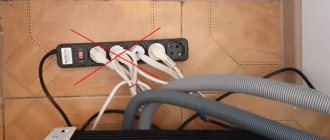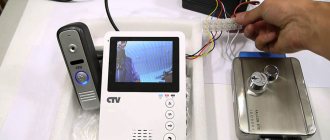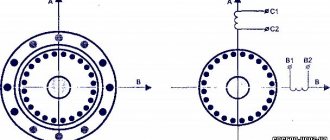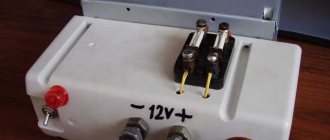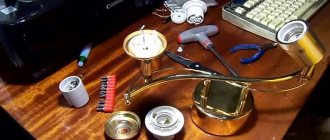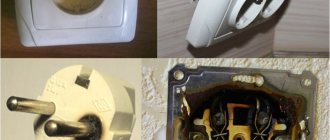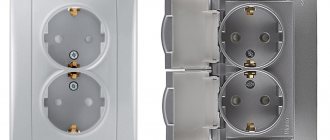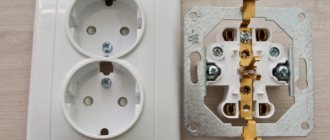Connecting the dryer to communications
Installing a dryer in a column also involves further connection to communications. The type of connection will depend on the type of dryer. Below we will look at all the options for connecting it.
Connection to ventilation
Everything is quite simple here. On one side of the case you will find a vent to which you need to connect the air duct. Fastening can be done using a special clamp. Usually this element is included in the kit. You need to know that you cannot bend the corrugation 90 degrees. Try to route the air duct with minimal kinks.
If the dryer will be connected in a room with a high temperature, then the flexible air duct cannot be routed through the top. In this case, you need to come up with another withdrawal option.
Connection to sewerage
If you purchased a condenser type dryer, then after each drying you need to remove the water tray. To make the work easier, you can connect it to the sewer. The connection in this case is no different from connecting a washing machine. You just need to lead the hose to the sewer.
Electrical connection
The last communication is considered to be the electrical network. To connect the dryer to the network with your own hands, you can remove a separate line from the distribution box. If necessary, if the dryer has low power, it can be connected to an outlet. To protect your equipment from overvoltage, you can connect an RCD.
As you can see, installing a dryer is a fairly simple process. Thanks to these instructions, you can save your money on calling a specialist.
Important nuances
Unfortunately, you cannot take two random Miele appliances and combine them into a single design. You will need to take into account the parameters of each machine, otherwise during operation many difficulties will arise, including failure of the equipment. Therefore, first study the recommendations we offer on site preparation, unit sizes and communications connections.
Dimensions. Miele machines should be identical in depth and width. Ideal if you purchase equipment in pairs at once. If you have already purchased a washing machine, choose a dryer based on the existing characteristics or a slightly smaller one.
Communications. Be sure to check the availability of sockets, ease of connection to water supply and sewerage. You can't just put a column where you want.
Fastening. You can use any of the methods indicated in our instructions, the main thing is to prepare the fastenings before purchasing the equipment. If you are planning a niche, buy sheets of drywall, screws, profiles and other necessary materials. As an option, order a cabinet to suit the required dimensions.
Attention! For safety reasons, it is prohibited to use the units simultaneously. It is better to wait and start the devices separately - this will significantly extend their service life and protect you from unforeseen troubles.
Before purchasing, study the intricacies of specific dryers. Some Miele models need to be connected to ventilation or, if there is no ventilation duct, the hose must be connected to a window. There are condensing machines that accumulate water in a special container. The container can be emptied at a time convenient for you. If you don’t want to do this regularly, try automatically draining the condensate into the sewer.
Installation methods
There are three common ways to install drying devices.
Mounting bracket
To place the dryer on top of the washing machine, you can use special mounting brackets, which are often supplied with the device. If they were not included in the kit, you will have to purchase such parts separately.
The fasteners are installed on top of the washer body so that the dryer can be attached to them. Without mounting fasteners, you should not install the device on top of the washing machine, since without reliable fixation the product may tip over due to operating vibration. Also, such fasteners are installed to additionally protect the surface of the dryer from scratches and other damage.
Reiki
Some people do not want to use mounting fasteners and therefore try to secure products in other ways. Often, strong wooden slats are used for this, which are attached to the surface of the wall. Then a dryer is attached to the installed slats, installed on top of the washing machine.
It is necessary to attach the slats to the wall very carefully and securely so that the structure does not become detached and fall.
Niche
There are times when it is not possible to place a dryer on top of a washing machine and you have to look for other methods of fastening. The most common is the use of a special niche, which is installed on the floor surface. You can purchase it or make it yourself. To make a high-quality niche, you can use high-strength plasterboard. When installing the device in a niche, you must remember that vibration occurs during its operation. Therefore, the distance between the wall and the structure should be 3-4 centimeters.
Placement methods
There are several ways to install a dryer yourself. In apartments and private houses installation can be carried out as follows:
- on top of the washing machine;
- next to the “washing machine”;
- in a special niche or closet;
- under the tabletop.
The most popular option is to install a dryer on a washing machine, which is also called “in a column”. In this case, you can save free space, which is especially important in small one-room apartments. In order to install the “dryer” above the washing machine in a column, you need to use special fasteners that are included in the kit.
Installation is quite simple - anti-tip mounts and special caps are installed on the washing machine body. After this, the body of the dryer is attached to the caps, the legs are unscrewed and the equipment is leveled. There is also the option of attaching to the wall using special slats, but it is used extremely rarely. The only important point is that the washing machine should not be narrow (this means dryers), otherwise the stability of the upper body will be questionable.
Please note that installing a dryer in a column without fastening and anti-tip elements is strictly prohibited. Firstly, these parts protect the washing machine from vibration damage, and secondly, they give stability to the dryer so that the equipment does not tip over during operation.
Here are some visual instructions for installing a dryer on a washing machine:
How to install equipment correctly
An easier installation option is next to the washing machine. In this case, more space will be required, but at the same time the equipment will be more stable and there will be no possibility of a negative impact of the dryer on the washing machine during operation. Most often, this option is used in spacious houses and apartments with a large bathroom or a separate room, for example, a wardrobe or laundry room. Installation is not difficult; you just need to install the case in the right place and unscrew the legs so that the equipment is set strictly at level.
If you are just renovating your apartment and are thinking about installing a drying machine, you can make a niche for it from plasterboard in advance. A more complex, but convenient option is to make a special cabinet for installation in a column. We recommend viewing both the first and second ideas in photo examples:
Well, the last installation option is under the countertop or sink. If the dimensions of the equipment are small, why not save space and install the case in the kitchen unit? This idea is very popular, and if you choose a condensing model, the sewerage system will be nearby, which will simplify connecting the dryer to the drain.
Features of placement of machines from different companies
There is no big difference in the installation of machines of different brands. The requirements for installation reliability are the same in all cases. For paired installations, it is recommended to use models of the same brand. This choice has a number of advantages:
Manufacturers offer sets of two units with fasteners, which greatly facilitates installation and ensures the safety and reliability of the design; some brands, for example, Bosch, Siemens, Asko and Gorenie, produce machines designed to be placed in a column, where the body of the washing machine is reinforced specifically for the weight of the dryer; connecting strips of such structures are specially designed to dampen vibrations and maintain stability; models from Bosch and Siemens may have a pull-out shelf; Asco has such a shelf equipped with a special laundry basket; drying units from Asko are equipped with additional fastenings for the legs; the Slovak Goreniya has suction cup legs; the undoubted advantage of choosing models from the same brand is style uniformity and the same dimensions, the latter condition is especially important for maintaining sustainability; when choosing narrow options for a small area, it should be taken into account that devices from Asco have a minimum depth, taking into account the mandatory free space at the back, it is 65.6 cm.
In cases where placement in a column is not allowed, the instructions indicate the minimum distance from above, which is necessary for the operation of the devices.
Column washer and dryer: Bosch and other brands
How to install two work surfaces - a washing machine and a dryer so that they do not take up much space, but take up space to a minimum? To achieve this, they have recently begun to use a method of organizing useful devices into a column.
You can always install a clothes dryer on top of the washing machine in any free room. This placement of machines can be used in the kitchen, in the bathroom, in a separate laundry room, and even in the hallway. But it should be understood that the devices need to be secured in such a way that the vibration emanating from one machine does not cause the other to suffer or fall. In addition, vibration should not affect the performance of both machines.
There are several mounting options:
- Installing the dryer on top of the washing machine using a special mounting bracket included with the dryer;
- Securing the dryer to slats that are mounted on the wall above the washing machine. For this case, the most important thing is to take into account the load to which the wall and shelf will be subjected, and safety precautions when fastening;
- Mounting machines into niches that can be made of thick plasterboard, plywood, or other suitable material.
Each home owner, taking into account the characteristics of the premises, can develop his own option for installing machines.
Vertical installation
By installing a dryer above a washing machine, you can save as much useful space in your home as possible. This simplifies access to devices during use. The devices can be installed in any room. Before starting work, you need to take care of the availability of communication connections. More details:
- The SMA must be placed in the right place. This should be done on a flat surface, moving at least 3 cm away from the wall.
- Install the mounting bracket with the dryer stand. At the same time, make sure that there is a rubber seal underneath it. It will reduce vibration levels.
- Secure the stand with bolts.
- Place the dryer so that its feet fit into the grooves on the stand.
- Secure the recesses from the outside using plugs.
Expert opinion
I work in the household appliance repair industry. Extensive experience in restoring washing machines and dishwashers.
Attention! The vertical column option is the most difficult to implement. When performing work, safety and installation rules must be strictly observed. The structure must be securely fastened. Installing a column without special fastening is strictly prohibited.
Important points:
- Before using fasteners, you should make sure they are secure.
- It is necessary to take into account how much the wall will withstand the load.
- You will have to use the devices one at a time.
- Both the washer and dryer should be about 3cm away from the wall.
The MCA should be at the bottom, but not vice versa. Its weight is much greater and vibrations during operation are stronger. Therefore, the dryer, regardless of the model and brand, is always placed at the top with this installation method.
Dryer placement
There are different ways to install a dryer. First of all, you need to proceed from the characteristics of a specific model, the amount of electrical equipment and the layout of the house. Most often, the dryer is installed in one of the following ways:
- on or above the washing machine;
- next to the washing machine;
- in a separate place (niche, closet, corner, etc.);
- under the tabletop.
In most cases, the dryer is located on top of the washing machine. Naturally, this option is only relevant for horizontal-loading washing machines. If things are loaded into the washing machine vertically, it is not recommended to install a drying unit above it, since this option will be inconvenient to use.
The key advantage of being positioned on the washing machine is that it saves space. Most units are equipped with special mounts for installation above the washing machine.
You need to use suitable fasteners; you can’t just put the car on top. If you simply place a dryer on top of a washing machine, both units may fail because they are not designed to withstand external vibration. Moreover, due to vibration during the washing process, the dryer may simply fall and break.
There are 2 options for mounting the drying unit:
- Fastening elements included in the delivery kit.
- On a specially mounted shelf. To install the latter, you can use available materials.
Naturally, the easiest way is to install the equipment nearby. However, in most modern apartments this is impossible to do due to limited space. This option is suitable only for the most spacious bathrooms.
Installation above the washing machine
When installing a dryer above a washing machine, you need to consider the following points:
First of all, it is important to correctly position the washing machine above which the drying unit will be installed. A special stand is installed on the washing machine to place the dryer. It is advisable to lay a rubber lining between the units. This will minimize vibration and, accordingly, reduce the degree of negative impact of one device on another. After installing the pad, you should install the dryer stand. The dryer should be placed on a securely fixed stand. All grooves, fasteners, etc.
you need to glue, paint over, cover up or perform other actions based on the parts used for installation.
Only after high-quality, reliable and correct installation can you begin to operate the equipment. While devices are not secured, they cannot be turned on.
Installing a dryer near the washing machine, in a niche or corner, is much easier. In this case, there is usually no need to use additional fasteners. However, each case has its own installation features. Including, you need to take into account the features of the layout and decoration of the room.
Where to put the dryer?
The connection issue is directly related to the placement of the machine in the room. The installation nuances depend on where it is and how it stands. Therefore, first we choose one of four options:
- on top of the washer;
- next to the washing machine;
- in a special niche or closet;
- under the sink or countertop.
Most often, dryer owners prefer the so-called “column”, when the dryer is installed directly on the washing machine. Square meters are greatly saved, which is what residents of small apartments and houses strive for. But you cannot simply put one unit on top of another - you must follow the instructions from the manufacturer.
- Check that the washing depth is greater than or equal to the drying depth. If there are mismatches, the “lower tier” will not withstand the load.
- Install special anti-tip latches and caps on the body of the washing machine. They come in combination with a dryer, if the possibility of installation in a column is provided.
- Unscrew the legs of the dryer and secure it in the caps.
- Adjust the position of the machine according to the building level.
There is another option - to use wall structures in the form of special slats. These fasteners are more reliable, but they are rare, since anti-tip fastenings are many times more aesthetically pleasing.
The provided latches cannot be neglected. They not only protect the washing machine from outgoing vibration, but also increase the stability of the “upper tier”, preventing the equipment from tipping down.
If you don’t want to mess with the fasteners, you should place the dryer next to the washing machine. This method is safer and simpler, but requires free space in the room. Suitable when there is a large area or the opportunity to place the machine in a separate room, closet, dressing room or spacious corridor. Installation in this case is limited to moving, removing transport bolts and leveling to the building level. It is better to immediately buy household appliances in pairs, so that a single style reigns in the bathroom or kitchen and the dimensions match exactly.
The option of installing the dryer in a plasterboard niche requires a special corner or cabinet. It is better to think about this in advance, even during the renovation of the premises. If possible, you can build a two-story structure with your own hands to accommodate both a dryer and a washing machine.
It’s even easier to identify the machine under the sink or kitchen countertop. You just need to choose the right model so that it has a removable lid for installation and dimensions that match the cabinets. A condenser dryer will fit especially well in the kitchen, since due to free access to the sewer system, connecting the dryer to the drain will not be difficult.
There is no reason to be afraid of installing a dryer - in many ways the procedure for connecting to communications is identical to washing machines. The main thing is to think about safety and not neglect the rules specified by the manufacturer.
Share your opinion - leave a comment
How to connect
There are certain features of connecting a dryer that need to be dealt with in advance.
Ventilation
Some people think that connecting a dryer to the vent is difficult, but this is not true. On one side of the dryer there is a special hole through which it is connected to the ventilation system. To secure the connecting corrugation, special clamps are used, which are supplied with the device.
The second side of the corrugation can be brought out into a vent in a window or into an opening in the central ventilation system
You must connect such a tube very carefully so that it does not bend by 80-90 degrees, as this will make it work worse
Sewerage
Condenser dryer models must be connected to a sewer system into which excess liquid will drain. Most of these devices have holes through which they are connected to the sewer. To connect the dryer and the sewer system, a regular hose is used, which can be led into the toilet, sink or separate drain.
Electricity
The last communication to which you need to connect the dryer is the electrical network. To connect it to a power source, you need to select a separate line on the distribution box. You can also use a free outlet. However, to connect such powerful equipment, you must use sockets that are equipped with separate grounding. However, experts do not recommend connecting a washer and dryer to the same double outlet at the same time.
Installation methods
There are two ways to secure the structure:
- using the fasteners that come with the dryer;
- using additional slats that are mounted on the wall above the washing machine.
The second option is used very rarely, since it is more convenient to use fastenings for drying.
Special mounts
These mounts are sold with your dryer. They are best suited for mounting the dryer on the surface of the washing machine.
Reiki
The slats are fixed to the wall directly above the surface of the washing machine. In fact, they form a kind of shelf on which the dryer is installed.
Niche
The niche is made of plasterboard. In addition to this, you need metal corners, putty, fasteners, finishing materials, and, most likely, a person who will make a niche out of all this, suitable in height, width and depth for installing a drying machine.
A type of niche can be a rack, where a washing machine will be installed on the lower “shelf”, and a dryer on the upper one.
Machine installation options
In line (in a row)
You can install a washing machine and dryer nearby where there are conditions for this and enough space (in the kitchen, bathroom, dressing room, hallway). With this arrangement, the upper surfaces of the two machines create an area that can be used advantageously. Build a tabletop on top, and you can hang a wall cabinet or shelf on top.
In order to save space, it is also a good option to install equipment in the kitchen unit under the worktop.
In a column (vertically)
Also, in order to save square meters, the method of installing appliances one on top of the other is widely practiced: at the bottom there is a washing machine; at the top there is a dryer (the other way around is not allowed in any case!).
An excellent solution for installing a dryer
A washing machine weighs much more than a dryer and is therefore always installed from below. Moreover, the floor must be smooth and durable (preferably concrete). Any uneven, soft (carpeting), slippery (linoleum) or wobbly surface (sagging plank flooring) will contribute to the already strong vibration of the unit.
To ensure that the dryer installed on top does not slip onto the floor during operation, you will have to work hard yourself, but if you do not have experience, it is better to contact a specialist.
Anti-tip fastenings and special parts (caps) are installed on the body of the washing machine. A dryer is installed in them. The stability of such a structure must be absolutely reliable and not raise the slightest doubt.
Another mounting method: the dryer can be mounted on the wall above the washing machine.
dryer on the wall
In both cases, installation requires special knowledge and skills. Therefore, entrust this work to professionals.
If you are planning a renovation, you can prepare a place for the devices in advance. Use drywall to build a special niche for installing both machines.
There are small compact models of drying devices designed for only 3 kilograms of laundry. Such equipment can simply be placed on top of the table or recessed into a niche in the kitchen unit.
Types of dryers
There are three types of dryers that people use most often.
Condensation
From the name of the technique, it becomes clear that when drying wet laundry, a process of liquid condensation is used. The drying process begins with heating the air to high temperatures, due to which the fabric gets rid of moisture. Then the laundry is cooled and moved to the lower part of the structure, where the heating element is located. The procedure is repeated several times. During this time, the liquid formed as a result of condensation moves into a special tank.
Among the advantages of condensing units is that there is no need to carry out additional work to install an air exhaust system. Therefore, such models can be installed in any room.
Exhaust
Exhaust dryers are used less frequently as they are considered obsolete. The main advantage of these models is the simplicity of their design and reliability. The operating principle of exhaust hoods is that excess moisture is drawn into a special ventilation hole. Therefore, before installing the dryer, you need to install a high-quality air duct. However, some people install equipment without it, which leads to increased humidity in the room and the appearance of mold and mildew on the surface of the walls.
People who live in a country house or in a private house should install the structure on the street.
With heat pump
Many manufacturers are trying to improve dryers so that they dry things better. Therefore, some models are equipped with a special heat pump, thanks to which drying becomes better.
Heat pumps are installed inside dryers to pump dry air so that it can better flow inside the device's chamber. The air then enters the evaporator, where it is cooled using a special refrigeration element. As a result, moisture collects from the surface of the fabric, causing things to dry.
Types of dryers
These machines are divided into several types:
- Drying cabinet.
- Drum drying.
The drying cabinet is quite difficult to use. Washed items will need to be hung by hand in a specially designated place. Excess moisture is removed using fans that supply warm air to the drying chamber. Electric or air heaters are used for heating. There is no point in connecting such a dryer to the sewer. All you have to do is use the spin mode and then transfer the items to the drying cabinet.
The design of the drum dryer, as well as the principle of its operation, resembles a drying cabinet. The difference is the presence of a special drum that speeds up drying. Thanks to rotation, hot air penetrates the fabric much faster. In addition, after using the drum machine, the need for ironing is reduced.
Such a device uses special programs that provide rotation mode, so things stop wrinkling. The drum dryer does not require a sewer connection. It is needed only if it is not possible to load wrung out items and manually drain unnecessary water from the tank.
Installing a dryer in a column with a washing machine
You can only connect a dryer on top of a washing machine using a special fastener. Many manufacturers of drying machines also include mounting brackets with their models. But sometimes, you have to purchase it yourself.
These connecting parts are also needed to prevent the machine from tipping over during operation, and in addition, they protect the washing machine from damage due to vibration. However, you should take into account that errors or illiteracy during installation will certainly create complications during operation. In view of this, if you are unsure of your own abilities, it is best to entrust the installation of devices to professionals.
Tips for installing and using machines:
- Do not stack machines directly on top of each other without perfect mounting. It is forbidden.
- Under no circumstances should you turn on two machines at the same time, even if you are sure that the wiring will withstand the load;
- It must be remembered that for vibrating machines it is necessary to leave a free space of 2-3 cm from the wall.
- Try to ensure that both machines are from the same manufacturer;
- If it is not possible to choose cars of the same brand, buy the same size.
When planning to install machines one on top of the other, be sure to check and clarify the availability of communications that will provide electricity, water and its drainage for both machines.
Benefits of using a drying machine
Before using the machine to dry washed clothes, you need to familiarize yourself with the advantages of these devices. The advantages of dryers include the following:
- The process of drying clothes is carried out very quickly and efficiently. After this, you don’t even have to hang things up to dry.
- The functional features of the devices allow you to dry clothes to the required level of humidity. This allows you to efficiently dry things made from capricious fabrics.
- The evaporation of moisture inside the dryers helps smooth the fabric. Therefore, there is no need to iron them again.
- Possibility of refreshing linen. This allows you to get rid of unpleasant odors that are embedded in the fabric.
However, such devices also have some disadvantages that you need to familiarize yourself with before purchasing and using them:
- high cost of modern models;
- bulkiness, due to which a lot of space will be required to install the dryer.
Installing two devices in a column correctly
There are three ways to install devices in a column, each of them differs in the nuances of fastening:
- The first option involves the use of an anti-tip kit, which is applied to the surface of the underlying device; the stability of the structure can only be ensured by standard fasteners recommended by the manufacturer.
- The second one rests on the rack fastener for the dryer; it is fixed on the wall above the level of the washing machine; in this case, the strength of the supporting wall will need to be taken into account.
- The third allows you to build both devices into a niche, which is assembled from load-resistant plasterboard or other high-strength materials.
The choice of the preferred method of installing a washing machine and dryer on top of each other or in a column depends on the layout, design, design features of the units, and other factors. In any case, the machines must be installed in compliance with certain rules:
- The recommendation remains unchanged to choose models from the same manufacturer that are similar in overall dimensions.
- If it is not possible to choose this option, you need to focus on the dimensions, which must match.
- The dryer is always placed above the washing unit, it is lighter in weight, its vibration is not so intense, which provides the necessary level of safety.
- The area for placing the equipment must be level, the lower unit should be placed level so that the column is strictly horizontal.
- It is undesirable to place the units on wooden or other soft floors, they increase vibration; the floors must be hard and prevent slipping during operation.
- The recommended distance between the devices and adjacent walls should be strictly observed, especially when choosing installation in a niche and on the rear side, where at least 2 to 3 cm of free space should be left.
It is important to remember that fixing devices without a reliable fastening strip and following other rules is fraught with loss of stability and the column falling. Breakdown of expensive equipment is not the only consequence of such negligence; it can pose a threat to the health of family members and especially children
Disadvantages of combined washing equipment
Unfortunately, there are a number of disadvantages that should also be noted:
- restrictions on loading laundry. Perhaps this is one of the main disadvantages. For example, equipment from Samsung washes up to seven kilograms of clothes in one cycle, and can dry it in half as much. It turns out that when the machine is fully loaded, clean laundry has to be dried in two passes, which will require more time and electrical energy. When buying an automatic washing machine with a similar function, remember that it is considered less economical. True, there are already devices capable of drying more than half of a full load at a time;
- price. Combination washing machines are thirty percent more expensive than their conventional counterparts. If someone is limited in financial resources, one should think about the feasibility of this acquisition;
- rapid wear of things. If the drying mode is used incorrectly, the laundry will wear out faster;
- machines with dryers do not have an anti-dust filter, which is installed on simple washing units.
Tags: , automatic, beat, sconce, view, choice, alignment, engine, house, , grounding, how, design, , tray, installation, power, connection, rule, principle, start, , work, repair, socket, row , light, network, system, connection, means, term, ten, type, current, installation, filter, shield, effect
Myth 9. Drying spoils items made from delicate fabrics.
In the new Candy models, drying is implemented using a heat pump, that is, a lower temperature is used than in condensing machines. This in turn does not wear things out, as already stated. Also, let's not forget about special drying modes, for example, the mode for wool - they are designed specifically for delicate fabrics.
In addition, modern washer-dryers are equipped with a steam mode, which not only saves electricity, but also helps to carefully wash delicate fabrics: steam treatment resembles boiling in its effect, but colored fibers retain their color. By the way, steam also disinfects clothes quite well, which is very important for children's clothes or things for people with allergies.
Recommendations and videos
More details:
- You should not install devices one on top of another just like that. This is a gross violation of operating rules and regulations and is therefore strictly prohibited.
- While the dryer is running, the washing machine should be turned off and vice versa.
- Do not forget that vibrating devices should not be placed close to the wall. There should be at least 3 cm between them.
- Two devices of the same brand are more convenient to use, and this option should be preferred.
- If it is impossible to purchase devices from the same company, they must still fit in size.
Installing washing machines and dryers in a column is a rational and simple way. It's not difficult to do this yourself. Before you start work, you need to study all the nuances. You should take care of the accessibility of communications, prepare a mount if necessary, and also carefully read the operating instructions for the device.
Installation depends on the type of dryer
How the process of installing a new dryer will proceed depends on the room and type of dryer.
First of all, it is important to decide on the type of drying, which can be exhaust, condensation or heat pump. The operating principles of the machines are different, which is reflected in the nuances of their connection.
- Exhaust systems work by removing air with moisture into the ventilation system, so the machine must be connected to home ventilation.
- Condensing machines direct heated air into a drum containing wet laundry, where it “collects” the liquid from the fabric. Next, the flow goes into the provided heat exchanger to “dump” the vapors, and the “dumped” moisture settles in the provided container. It needs to be emptied, so for convenience it needs to be connected to a sewer.
- Heat drying units are similar to condensing models with the difference that the moist air does not pass through a heat exchanger, but an evaporator.
The most difficult thing to work with is exhaust models, since they require connection to an air duct. Not all city apartments and private houses provide the opportunity to easily connect to centralized ventilation. But fewer and fewer such machines are being produced - manufacturers are actively replacing them with condensing and “heat pump” ones. We will talk about their installation in the article.
Mounting methods
Main types of clothes dryers:
- exhaust;
- condensation;
- using a heat pump.
Connecting different types of dryers is done differently. For example, exhaust types are connected to a ventilation hood and its operating principle is based on the fact that it dries clothes by releasing moist air into the ventilation. Condensation models work on the following principle: hot air passes through the chamber with the laundry, and from there it removes moisture into a special heat exchanger, which then settles in a special collector (tray). After drying, it is necessary to drain the liquid that has settled in the tray. Machines with a heat pump work in approximately the same way as condensing machines, with the difference that moisture does not enter the heat exchanger, but the evaporator. Some models, like washing machines, require connection to a sewer system to get rid of moisture and condensation. Consequently, they create additional inconvenience.
